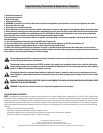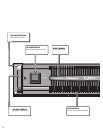
9
REAR PANEL FEATURES
INPUT CONNECTIONS
•Precision balanced inputs offer superior hum rejection, and accept >21dBu input levels on all Sensitivity settings (see
Specs).
•Female and Male XLR, Pluggable Terminal Blocks, and DataPort Input signals are all wired in parallel for each channel.
•Paralleled DataPort routing is used for the first time on the PL3 series. Therefore, DataPort-connected signals can be
patched to other amplifiers. Do not use unbalanced connectors as this will unbalance and possibly affect the level of all
signals connected to that channel.
•Because the DataPort signals on the PL3 Series are connected like any other input, the Sensitivity switch will affect gain for
these inputs as well. QSControl devices will read the setting of the Sensitivity Switch to allow for this.
REMOTE MONITORING – DATAPORT
•All DataPort connected accessories are supported. The usual signals representing output voltage, output current, clipping,
temperature, supply voltage and switch status are provided, plus remote control Standby. The current version of QSControl
will read a unique ID code and know what PL3 models are connected without operator intervention.
CLIP LIMITING, ON-OFF SWITCH (Ch1, Ch 2)
•Each channel provides a Clip-Limit switch; with an adjacent yellow LED for “ON”. PL3 Clip Limiting is designed to reduce
the audibility of clipping without changing the program dynamics in any other way. It replaces harsh clipping with very
rapid limiting, “reducing” rather than “eliminating” clipping. This is not a substitute for long-term power limiting, as aver-
age program levels can still be driven very high.
HIGH PASS FILTER, 3-POSITION SWITCH (Ch1, Ch2)
•For simple systems, second-order (12dB/octave) filters can be engaged at 30Hz (yellow LED) or 50Hz (orange LED). These fil-
ters can prevent speakers from sub-audio overload, but can have an audible effect on percussive material. Their effect
should be auditioned carefully. When bypassed (no LED), the low frequency response extends to about 3Hz. In this wide-
band mode, very large sub-audio transients may trigger brief protective muting.
INPUT MODE SWITCH, 3-POSITION: BRIDGE, STEREO, PARALLEL
•BRIDGE MONO MODE (Yellow LED): Sends Ch1 signals out-of-phase to Ch2, producing twice the normal voltage swing
between the two “hot” speaker terminals (Ch1 “hot” is defined as positive). Only Ch1 controls and input are effective. USE
EXTREME CAUTION when connecting speakers. Depending on the model, hundreds of volts and thousands of watts are
available. NOTE: it is normal for the Br Mono indicator LED to transition slowly.
•STEREO MODE (Green LED). Each channel operates independently, as usual.
•PARALLEL INPUT MODE (Orange LED). The inputs of both channels are hard-switched together, but all controls and
speaker connections work as usual. Do not attempt to parallel the output channels to the same load.
INPUT SENSITIVITY SWITCH, 3-POSITION: 26dB, 32dB, 1.2V
•The 26dB (Orange) and 32dB (Green) settings provide the same voltage gain for all models. When using these settings, all
models will sound equally loud, but the more powerful amp will have more headroom.
•The 1.2V setting provides the same input sensitivity for all models. Larger amps will sound proportionally louder, with the
same amount of headroom.
•The resulting input sensitivities and gains for each model are shown in the Specs.
SPEAKER CONNECTIONS – SPEAKONS
•Ch1 provides “4-wire” access to both channels using the standard convention: Ch1 uses 1+, 1-, and Ch 2 uses 2+ and 2-.
•Ch 2 provides “2 wire” access to Ch 2 only, using 1+, 1-.
SPEAKER CONNECTIONS – BINDING POSTS
•WARNING: use safe wiring practice as peak output voltages can be hazardous.
AC POWER CABLE AND AC VOLTAGES.
•PL3 Series amplifiers are configured for specific AC voltages. The products operate safely over the normal range of AC line
variation but rated performance applies only at rated voltage.
•Where regulations permit, products feature locking detachable cordsets, and are shipped with AC plugs suitable for the
intended AC voltage (see Specs).














